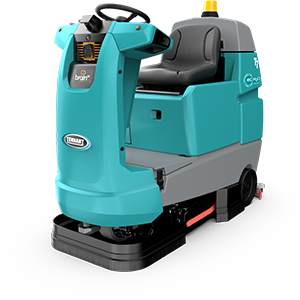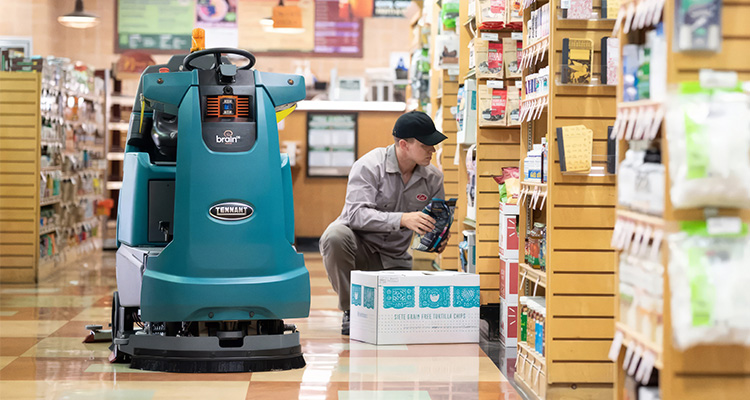Michel Spruijt shares how Brain Corp empowers organizations to automate and infuse intelligence into core operations
I started work in the printing industry and from there, moved into the IT accessory business,” Michel Spruijt, President of Brain Corp International, begins. “I held the position of General Manager EMEA at Ergotron, which builds kinetic work environments. During my 20-year tenure, I successfully built cross-functional teams and managed Ergotron’s growth trajectory in EMEA. I held several roles, including management positions in business development, sales, operations, customer care, technical support, and business operations.”
Michel joined Brain Corp in 2019 as VP and General Manager for Europe. He is responsible for all partner support, team expansion, and the oversight of general operations internationally. Founded in 2009, Brain Corp is an autonomous technology company creating transformative solutions in robotics and AI. With over 37,000 autonomous mobile robots (AMRs) deployed globally, its autonomy software, BrainOS®, is enhancing productivity, efficiency and safety across commercial spaces like retail stores, schools, and warehouses. Through innovation and strategic partnerships, Brain Corp pioneers the commercial robotics domain, envisioning a future where robots are as common as computers and mobile phones.

“Brain Corp wanted to expand beyond the US and the company asked me if I was willing to lead and build the EMEA office. I work with a great team of people across Europe, in a fast-paced and dynamic industry. Retail automation is our specialty and BrainOS® powers automation especially for retail, helping to manage inventory, tour stores aisle-by-aisle, and keep floors clean.
“Of the over 240 people working at Brain Corp,” he continues, “more than 150 are engineers who work on solutions to empower organizations to automate and infuse intelligence into core operations. Currently, there are over 37,000 robots running with our software. We have products that make sense of stores’ inventory. Retailers can gain clearer operational visibility through AI-powered inventory analytics and autonomous inventory scanning robots. To realize our software solutions, we always work closely with the hardware OEMs.
“I think one of the biggest challenges now is whether manufacturers can make the strategic decision to implement robotics at scale. Implementing a single robot may not be adequate to demonstrate value, you need to look at the bigger picture. As such, it’s important to regularly evaluate when the time is right to adopt robotics in a way that optimizes operations. For instance, BrainOS®-powered autonomous floor care robots increase cleaning capacity amid labor and operational challenges. Organizations can leverage intelligent tools to automate workflows, optimize operations, reduce costs, and unlock valuable insights.
Actionable insights
“If it’s difficult to find enough people to perform cleaning tasks, for example, then robotics provides a possible solution. While the savings may not be immediately evident on a single site, imagine multiple locations and the benefits become clearer. It’s all about asking the right questions and ensuring that the robots complement the workflows. Manual cleaning is time-consuming. Autonomous robots help free employees from repetitive tasks so they can focus on other valuable tasks, while also enabling them to upskill by becoming robot managers. Staff are empowered to achieve their full potential while robots maintain high cleaning standards. Leveraging performance data and analytics from robots facilitates continual optimization of cleaning operations. Brain Corp’s suite of reporting tools provides actionable insights, including being able to see what has and hasn’t been cleaned. The robots intelligently perceive their surroundings and immediately react to obstacles, helping prevent accidents and equipment damage,” he elaborates.
 “By constantly evaluating processes and resolving problems, we’re able to improve the robots’ performance. If one robot experiences an issue in situ, we’ll resolve the challenge, which means if we solve it for one, we solve it for all. This process of refinement comes from ironing out complications. Detailed performance statistics and heat maps generated by our platform provide valuable, actionable insights. Analyzing this cleaning usage data allows you to easily identify areas for improvement and optimize schedules and routes. You’ll also have the compliance reporting required to quantify productivity. This data can drive decision making and enable process optimization.
“By constantly evaluating processes and resolving problems, we’re able to improve the robots’ performance. If one robot experiences an issue in situ, we’ll resolve the challenge, which means if we solve it for one, we solve it for all. This process of refinement comes from ironing out complications. Detailed performance statistics and heat maps generated by our platform provide valuable, actionable insights. Analyzing this cleaning usage data allows you to easily identify areas for improvement and optimize schedules and routes. You’ll also have the compliance reporting required to quantify productivity. This data can drive decision making and enable process optimization.
Critical message
“I think that in the next two years, a lot of people will see the value of robotics; I’m hoping that they will see it not as a threat, but rather an opportunity. AI and automation are here to stay, and with the labor market set to remain under pressure, we will need automation to enable us to continue doing what we’re doing. AI will help us overcome the burden of labor shortages, eradicating dangerous, dull, and repetitive work, thereby contributing to improving people’s health. The critical message I want to get across is the importance of being open to automation and AI, as it’s not going anywhere. If it’s not quite right for now, it might be for the future.
“I don’t think AI will cost jobs,” Michel concludes, “I think it will create more jobs, but the jobs will be different. If people are not willing to change what they did yesterday, nothing will change tomorrow. Being open minded and willing to accept change can facilitate the adoption of AI and robotics and ensure a more seamless integration with workflows.”
